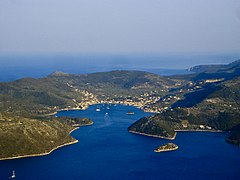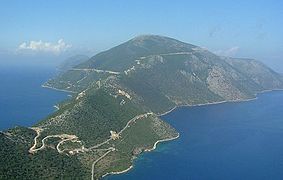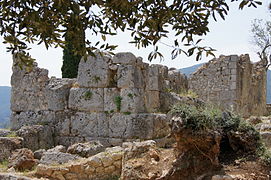Ithaca
![]()
The title of this article is ambiguous. For other meanings, see Ithaca (disambiguation).
f9f10f8
Ithaca (Greek Ιθάκη Itháki [iˈθakʲi] (f. sg.)) is one of the Ionian Islands off the west coast of Greece. Together with some uninhabited islets, it forms the municipality of Ithaca (Δήμος Ιθάκης Dímos Ithákis), which as the Regional District of Ithaca (Περιφερειακή Ενότητα Ιθάκης Periferiakí Enótita Ithákis) of the Ionian Islands Region sends one deputy to the Regional Council.
The island has an area of 95.8216 km². Highest elevation is the Niritos with a double peak of 809 and 806 m. The main town and port is the village of Ithaki in the southern part of the island. The island is very green and has many sheltered bays, which are especially popular with sailors. The northern and southern parts are separated by the Molos Gulf and are only connected by the narrow isthmus of Aetos, which is about 620 m wide. Numerous buildings were destroyed in an earthquake in 1953.
Ithaca can be reached today by ferry from Lefkada, Kefalonia, Astakos (Akarnania) and Kyllini (Elis). In addition to Ithaki, the ferries call at the ports of Frikes in the north of the island and Piso Aetos in the south of the island (west coast).
Mythical home of Odysseus
Ithaca is also the name of Odysseus' home island in Homer's epics. Whether the Homeric Ithaca corresponds to the present-day island of Ithaca, which has been so named in ancient written sources since at least the 5th century BC, is a matter of dispute among researchers. Heinrich Schliemann believed he had discovered Odysseus's palace on Mount Aetos because some of Homer's descriptions of the site can be matched with the landscape, and the summit is fortified with an extensive cyclopean wall, suggesting a Mycenaean settlement. Schliemann's conclusions are disputed, however, and another site on the island competes for the ancient palace site.
Wilhelm Dörpfeld considered Lefkada to be the Homeric Ithaca, since, among other things, the topographical indications and more extensive geographical statements about the territory of Odysseus in Homer make the identification of Lefkada with the Homeric Ithaca probable in his opinion. Among other things, Dörpfeld pointed out that for the localization of the island of Asteris, where the suitors lay in wait for Telemachos, only the islet of Daskalio would come into question, should the Homeric Ithaca correspond to the present one. Dörpfeld, on the other hand, equated Asteris with the much larger island of Arkoudi, south of Lefkada, which, in accordance with Homer's statements, offered two natural harbours and from which one had a good view of the sea. Dörpfeld also referred to several passages in the Odyssey in which Telemach asks visitors to Ithaca who are strangers to him:
What [is] the ship in which thou camest? How did the mariners bring thee hither
to Ithaca? How do they boast of being called?
For thou camest not hither on foot.
Dörpfeld rejected the idea that reaching Ithaca on foot could be a joke on Homer's part, since a "joke... is wholly inappropriate" in the scene in which Odysseus reveals his true identity to his son. If Homeric Ithaca were equated with present-day Ithaca, the passage would make no sense, but it would if it were identical with Lefkada. Also, before the Corinthians created a navigable channel between Lefkada and the mainland around the middle of the 7th century BC, a shallow strait had separated Lefkada from the mainland. The poor would therefore have been able to reach Lefkada on foot and by simple ferries, which would also have carried cattle for slaughter across the strait; the rich, on the other hand, would have come by ship. Dörpfeld's view, however, could not prevail in research. Although he found remains of Mycenaean tombs and settlements during excavations, he did not find a palace, which he had assumed.
British entrepreneur and amateur historian Robert Bittlestone is looking for Homeric Ithaca on the peninsula of Paliki (Greek Παλική) on the west coast of the neighboring island of Kefalonia, since in his view the following description from the ninth canto of the Odyssey can hardly be reconciled with the nature of the island today:
Ithaca's sunny heights are my home; in this door
Neriton's head with rustling tops rises; and around it,
sown close together, are many populated islands,
Same, Dulichion, and the forest-grown Zakynthos.
Ithaca lies in the sea highest up to the fortress,
Towards the north; the others are distant east and south.
Paliki, on the other hand, is not an independent island today, but a part of Kefalonia (Dimos Palikis was the official name of the municipality of Lixouri until 2010). However, there are indications that it once was in archaic times. Strabon, for example, speaks in the 1st century BC of a place on Kefalonia that is often flooded by the sea. If Paliki was indeed an island in its own right, it would come closest to the description in Homer.
This theory is supported by the British geologist John Underhill, who examined the rock strata between the Paliki peninsula and Kefalonia. He did not find any solid rocks, but only sediments and debris, which may have connected the two islands by seismically caused landslides.
Historian Heinz Warnecke also suspects that the Homeric Ithaca is in fact Kefalonia. Warnecke bases his thesis on geographical and historical findings: Homer describes Ithaca as the westernmost and highest of the western Greek islands ruled by Odysseus. This description fits Kefalonia much better than today's Ithaca. Also, compared to Kefalonia, Ithaca was much too small and insignificant to be suitable as a royal seat in a heroic epic.
In the meantime, in the north of Ithaca, near Exogi, remains of a three-storey building with a staircase carved into a rock, as well as a well, among other things, were discovered and partially excavated. Based on Mycenaean pottery also found there, the remains are dated to the 13th century BC. The excavator, Tanasis Papadopoulos, considers the complex to be the remains of a Mycenaean palace and associates it with the palace of the mythical Odysseus described in Homer.
Literary Kings of Ithaca
- Arkeisios
- Laertes
- Ulysses
- Telemachos
Recent history
The island was conquered by the Normans in 1185 and subsequently belonged to the Palatine County of Kefalonia and Zakynthos of Margaritos of Brindisi. After his blindness in 1194, it fell to his son-in-law Maio Orsini, who finally submitted to Venice in 1209. The island was named Cefalogna Piccola by the Venetians in reference to the neighbouring island of Kefalonia, with which Ithaca is culturally linked. Great damage was caused by the earthquake in August 1953.
· 
Bay and harbour of the main village Vathy
· 
The northern part of the island, seen from Mount Aetos
·
Wall remains of a Bronze Age building on Ithaca
·
The Kathara Monastery near Anogi
Population
Today the island has about 3,000 inhabitants. When Heinrich Schliemann visited the island in 1868, it still had about 12,000 inhabitants. Many of the inhabitants have emigrated over time, mainly to Australia, the United States of America and South Africa.
Municipality of Sarakiniko
In 1978, a commune was formed on the Sarakiniko peninsula under the name Sarakiniko Alternatives Leben GmbH. Most of the residents commute to Germany, only about a dozen people live there permanently today (as of 2010). As a follow-up project, the off-grid ecovillage Ecotopia was established in 2010.
Search within the encyclopedia

,_near_Anogi_on_Ithaka.JPG)